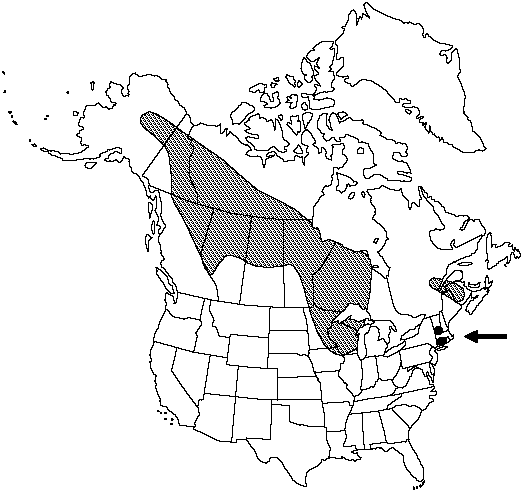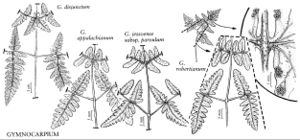Difference between revisions of "Gymnocarpium jessoense subsp. parvulum"
Ann. Bot. Fenn. 15: 103. 1978.
imported>Volume Importer |
GeoffLevin (talk | contribs) (Added Nunavut to distribution; treatment was published before Nunavut split from N.W.T.) |
||
| Line 30: | Line 30: | ||
|habitat=Acid or neutral substrates at summit of cool, shale talus slopes, and on granitic cliffs and outcrops | |habitat=Acid or neutral substrates at summit of cool, shale talus slopes, and on granitic cliffs and outcrops | ||
|elevation=0–2000 m | |elevation=0–2000 m | ||
| − | |distribution=Alta.;B.C.;Man.;N.B.;N.W.T.;Ont.;Que.;Sask.;Yukon;Alaska;Conn.;Iowa;Maine;Mich.;Minn.;Vt.;Wis.;Europe in Finland;Asia in Siberia;Kazakhstan. | + | |distribution=Alta.;B.C.;Man.;N.B.;N.W.T.;Nunavut;Ont.;Que.;Sask.;Yukon;Alaska;Conn.;Iowa;Maine;Mich.;Minn.;Vt.;Wis.;Europe in Finland;Asia in Siberia;Kazakhstan. |
|discussion=<p>Hybrids between <i>Gymnocarpium jessoense </i>subsp.<i> parvulum</i> and <i>G. dryopteris</i> (G. × intermedium Sarvela) are usually found wherever these two taxa occur together (Finland; Manitoba, Northwest Territories, Ontario, Quebec, Saskatchewan, Yukon; Alaska, Michigan, Minnesota, Wisconsin), and they are particularly abundant in the Great Lakes region. These hybrids have sometimes been referred to as G. × heterosporum, a name that is, however, correctly restricted to unique hybrids between <i>G. robertianum</i> and <i>G. appalachianum</i> (see discussion under <i>G. robertianum</i>; K. M. Pryer 1992). <i>Gymnocarpium</i> × intermedium is intermediate between the two parental species in its leaf morphology and glandularity, and it can be readily distinguished by its small, blackish, malformed, abortive spores, as well as large, brown, round spores that may allow this taxon to reproduce apogamously. Of the <i>Gymnocarpium</i> sterile hybrids, G. × intermedium is the easiest to distinguish morphologically.</p> | |discussion=<p>Hybrids between <i>Gymnocarpium jessoense </i>subsp.<i> parvulum</i> and <i>G. dryopteris</i> (G. × intermedium Sarvela) are usually found wherever these two taxa occur together (Finland; Manitoba, Northwest Territories, Ontario, Quebec, Saskatchewan, Yukon; Alaska, Michigan, Minnesota, Wisconsin), and they are particularly abundant in the Great Lakes region. These hybrids have sometimes been referred to as G. × heterosporum, a name that is, however, correctly restricted to unique hybrids between <i>G. robertianum</i> and <i>G. appalachianum</i> (see discussion under <i>G. robertianum</i>; K. M. Pryer 1992). <i>Gymnocarpium</i> × intermedium is intermediate between the two parental species in its leaf morphology and glandularity, and it can be readily distinguished by its small, blackish, malformed, abortive spores, as well as large, brown, round spores that may allow this taxon to reproduce apogamously. Of the <i>Gymnocarpium</i> sterile hybrids, G. × intermedium is the easiest to distinguish morphologically.</p> | ||
|tables= | |tables= | ||
| Line 48: | Line 48: | ||
|habitat=Acid or neutral substrates at summit of cool, shale talus slopes, and on granitic cliffs and outcrops | |habitat=Acid or neutral substrates at summit of cool, shale talus slopes, and on granitic cliffs and outcrops | ||
|elevation=0–2000 m | |elevation=0–2000 m | ||
| − | |distribution=Alta.;B.C.;Man.;N.B.;N.W.T.;Ont.;Que.;Sask.;Yukon;Alaska;Conn.;Iowa;Maine;Mich.;Minn.;Vt.;Wis.;Europe in Finland;Asia in Siberia;Kazakhstan. | + | |distribution=Alta.;B.C.;Man.;N.B.;N.W.T.;Nunavut;Ont.;Que.;Sask.;Yukon;Alaska;Conn.;Iowa;Maine;Mich.;Minn.;Vt.;Wis.;Europe in Finland;Asia in Siberia;Kazakhstan. |
|reference=None | |reference=None | ||
|publication title=Ann. Bot. Fenn. | |publication title=Ann. Bot. Fenn. | ||
Latest revision as of 17:37, 24 September 2021
Stems 0.5–1.5 mm diam.; scales 1–4 mm. Fertile leaves usually 8–39 cm. Petiole 5–25 cm, with moderately abundant glandular hairs distally; scales 2–6 mm. Blade narrowly deltate to narrowly ovate, 2-pinnate-pinnatifid, 3–14 cm, firm and robust or lax and delicate, abaxial surface moderately glandular, rachis moderately to densely glandular, adaxial surface glabrous. Pinna apex acute. Proximal pinnae 2–9 cm, strongly curved toward apex of leaf, basiscopic pinnules strongly curved toward apex of pinna; basal basiscopic pinnule usually sessile, pinnatifid or rarely pinnate-pinnatifid, if sessile then with basal basiscopic pinnulet often equaling adjacent pinnulet; 2d basal basiscopic pinnule sessile, with basal basiscopic pinnulet equaling adjacent pinnulet; basal acroscopic pinnule sessile with basal basiscopic pinnulet longer than or equaling adjacent pinnulet. Pinnae of 2d pair almost always sessile with basal basiscopic pinnule usually equaling or slightly shorter than adjacent pinnule and equaling basal acroscopic pinnule; basal acroscopic pinnule equaling or slightly shorter than adjacent pinnule, apex often entire, rounded. Pinnae of 3d pair sessile with basal basiscopic pinnule equaling adjacent pinnule and equaling basal acroscopic pinnule; basal acroscopic pinnule equaling or slightly shorter than adjacent pinnule. Ultimate segments of proximal pinnae oblong, entire to slightly crenate, apex entire, rounded. Spores 32–37 µm. 2n = 160.
Habitat: Acid or neutral substrates at summit of cool, shale talus slopes, and on granitic cliffs and outcrops
Elevation: 0–2000 m
Distribution

Alta., B.C., Man., N.B., N.W.T., Nunavut, Ont., Que., Sask., Yukon, Alaska, Conn., Iowa, Maine, Mich., Minn., Vt., Wis., Europe in Finland, Asia in Siberia, Kazakhstan.
Discussion
Hybrids between Gymnocarpium jessoense subsp. parvulum and G. dryopteris (G. × intermedium Sarvela) are usually found wherever these two taxa occur together (Finland; Manitoba, Northwest Territories, Ontario, Quebec, Saskatchewan, Yukon; Alaska, Michigan, Minnesota, Wisconsin), and they are particularly abundant in the Great Lakes region. These hybrids have sometimes been referred to as G. × heterosporum, a name that is, however, correctly restricted to unique hybrids between G. robertianum and G. appalachianum (see discussion under G. robertianum; K. M. Pryer 1992). Gymnocarpium × intermedium is intermediate between the two parental species in its leaf morphology and glandularity, and it can be readily distinguished by its small, blackish, malformed, abortive spores, as well as large, brown, round spores that may allow this taxon to reproduce apogamously. Of the Gymnocarpium sterile hybrids, G. × intermedium is the easiest to distinguish morphologically.
Selected References
None.
